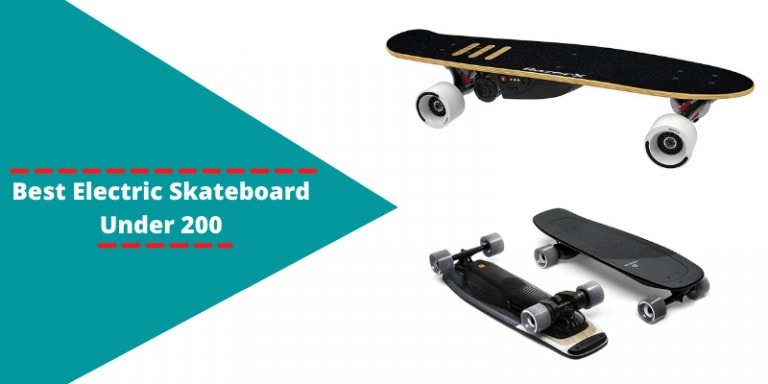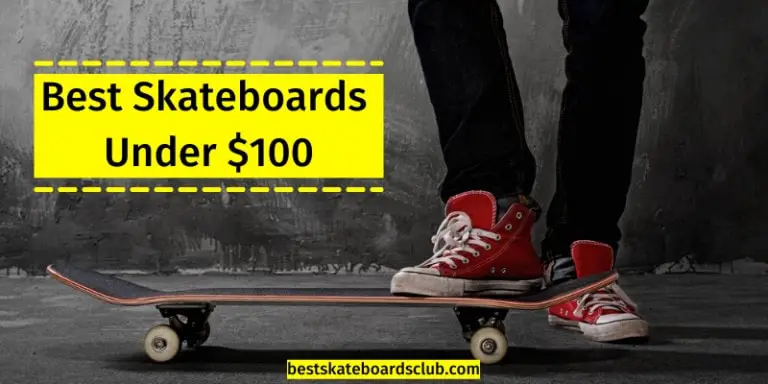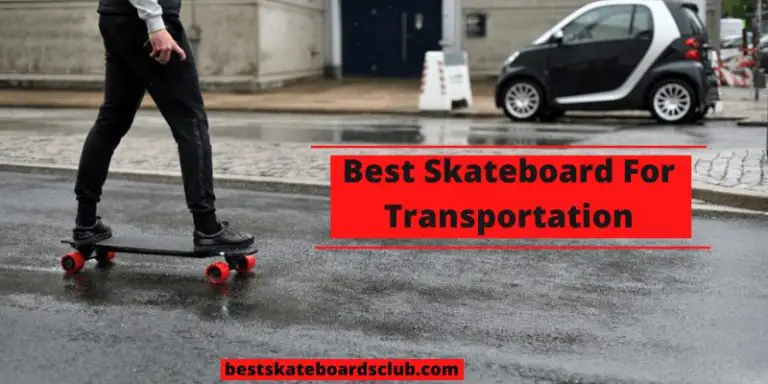Do You Need Risers On A Skateboard?
If you are new to skateboarding one of the most confusing things for you might be risers. So do you need risers on a skateboard?
Skateboards usually don’t need riser pads however, if the skateboard has bigger wheels then risers are needed to prevent the wheels from rubbing on the deck and minimize the wheel bite. Risers also help in dampen the vibrations and help keep the deck stable during the ride.
However, that’s not all and there’s definitely a lot more to know when it comes to knowing whether you need risers on a skateboard or not. After reading this article, you will learn everything about the right size and placement of risers, how to install them and what are the benefits of using risers.
So if that sounds interesting enough to you then make sure to read this article to the end! With that said, let’s get into it.
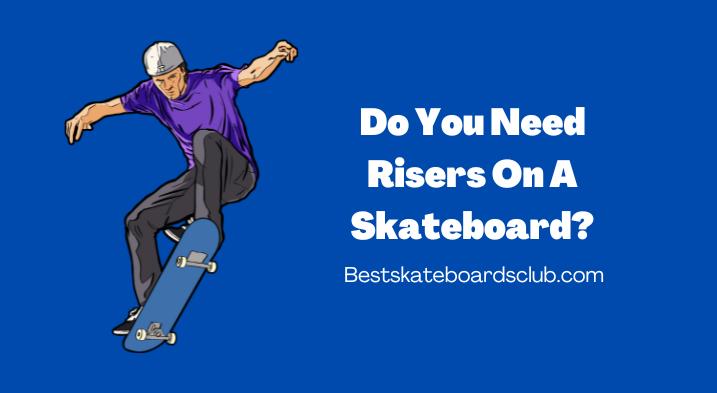
Do You Need Risers on a Skateboard?
As I already mentioned, skateboards usually don’t need risers. In fact, most of the time you won’t even see anyone using them as it’s not really necessary.
However, there are certain cases where you might need to use risers on your skateboard. The most common case is when the wheels of your skateboard are bigger than the usual size.
For example, if you have 60mm wheels on your skateboard then risers are a must. This is because the bigger the wheels, the more likely it is for them to rub against the deck and cause wheel bite.
Wheel bite is when the wheels of your skateboard touch the deck and stop abruptly, causing you to lose balance and fall off. Risers help to prevent this from happening by raising the wheels off the deck slightly.
Another reason why you might need risers is to dampen the vibrations of your skateboard. If you live in an area with a lot of cracks and bumps then risers can help to smooth out the ride and make it more comfortable.
Lastly, risers also help to keep the deck of your skateboard more stable. This is especially important if you are doing tricks that require a lot of balance.
Riser Pads VS Shock Pads: What’s the Difference
Another thing that most beginners may not know about is that there are two types of pads that you can use on a skateboard – riser pads and shock pads.
So what’s the difference between the two? Riser pads are used to raise the trucks of your skateboard off the deck slightly, while shock pads are used to dampen the vibrations of your skateboard.
Shock pads are usually made of softer materials such as foam or rubber, while riser pads are usually made of harder materials such as plastic.
Riser pads are typically used in conjunction with shock pads to provide both the benefits of each pad. However, you can also use either pad on its own depending on your needs.
For example, if you only need to raise the trucks of your skateboard then you can just use riser pads. Or if you only need to dampen the vibrations of your skateboard then you can just use shock pads.
Types of Riser Pads
Riser pads can be divided into two main types based on their shape and purpose. Let’s take a closer look at each one of them and know their purpose.
Flat Risers:
As the name suggests, flat risers are riser pads that are flat in shape. These types of riser pads are typically used to raise the trucks of your skateboard by a small amount (usually 1/8” or 3mm).
The main purpose of using flat risers is to prevent wheel bite without affecting the turning of your skateboard too much. Flat risers are also the most common type of riser pads used by skateboarders as they offer a good balance between function and form.
Wedged or Angled Riser Pads:
Wedged or angled riser pads are riser pads that are wedge or angle shaped. These types of riser pads are typically used to raise the trucks of your skateboard by a larger amount (usually 1/4” or 6mm).
Such type of riser pads is not meant for skateboarding at all. These are commonly used for cruisers and longboards which helps in greatly improve the turn radius of the board. Depending on how you set the risers, you can turn your board into a very responsive carving machine or a very stable cruiser.
Risers for Different Skateboard Wheels
The size of the riser pads that you need also depends on the size of the wheels that you are using. For example, if you have 60mm wheels on your skateboard then you will need bigger risers than someone who has 50mm wheels.
The reason for this is that the bigger the wheels, the more likely they are to touch the deck when you make a turn. This is why it’s important to choose the right size of risers for your skateboard wheels.
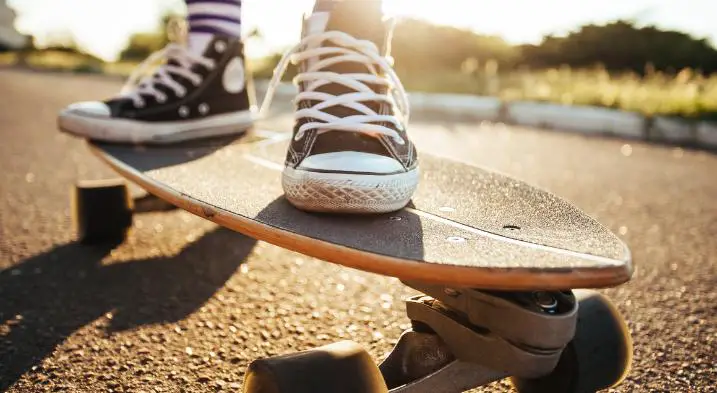
Why Do People Use Skateboard Risers?
Risers are usually made of plastic or metal and come in different sizes, depending on the size of the trucks and the board. They’re designed to raise the deck off the ground, which gives you more clearance when turning.
This is especially important if you have big wheels or wide trucks, as they can make it difficult to turn without getting caught up on small bumps in the pavement. Below are some of the most common reasons why risers are used on skateboards and how they help during the ride.
Skateboard Risers Absorb the Shock
Whenever you jump from a surface or ride your skateboard on a bumpy road your skateboard experiences a shock. Although we won’t explain all those boring and nerdy physics equations and terms here, risers help dampen those shocks by absorbing the impacts.
This way you don’t feel any pain after landing an ollie, dropping or jumping from some height. Moreover, risers add extra cushion between the deck and trucks which improves your skating experience.
Skateboard Risers Add More Stability
Risers are used to increase the stability of your skateboard. This is especially beneficial if you’re riding on uneven surfaces or doing tricks that require you to move in multiple directions quickly.
Having a little more clearance, it makes it easier for you to adjust and turn without getting caught up on bumps or cracks in the road.
Plus, with added stability comes better control over your board as well as increased safety. Skateboarding is already dangerous enough, so having risers helps make it a bit less treacherous.
Skateboard Risers Give You More Room For Big Wheels
Skateboard risers are especially helpful if you’re using large wheels or wide trucks on your board. Without them, the wheels and trucks can hit the ground when you turn, which can make it difficult to maneuver.
But with a set of risers in place, you have more room for your larger items and can easily turn without running into any issues. Apart from that, when you are using bigger wheels on your skateboard there is a higher chance of experiencing a wheel bite.
Point to Pounder – Wheel bite is when your wheels touch the skateboard deck while you’re skating. It can be quite dangerous and can lead to severe accidents.
Risers Help Improving the Turning Radius
Last but not least, skateboard risers also help to improve the turning radius of your board. Without them, you’ll have a hard time trying to turn quickly or make sharp turns without getting caught up in cracks and bumps in the road.
But with a set of risers installed, it makes it much easier for you to maneuver and turn your board without having any issues with the terrain.
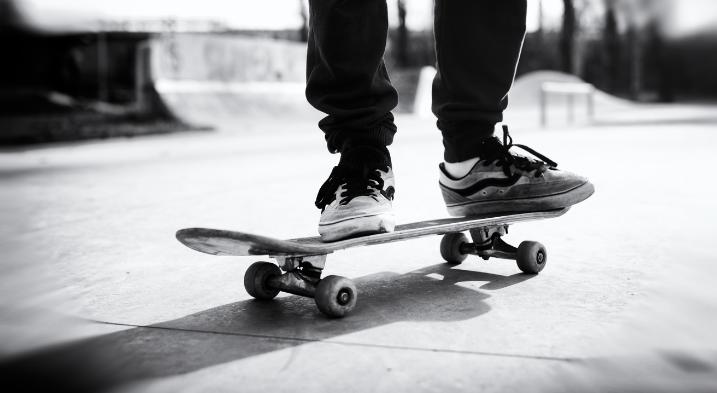
Skateboard Riser Pads Installation
Installing riser pads on your skateboard is a pretty straightforward process. The first thing that you need to do is to remove the old riser pads from your skateboard (if you have any).
Next, take the new riser pads and place them on top of the trucks. Make sure that the holes on the riser pads are aligned with the holes on the trucks.
After that, take the bolts and lock washers and thread them through the holes on the riser pads and trucks. Make sure to use the right size of bolts as using too small or too big of bolts can strip the threads on the holes.
Finally, tighten the bolts using a wrench or a socket driver. Once the bolts are tight, you can go ahead and test your skateboard to see if the new riser pads are working properly.
If you find that the new riser pads are not working as intended then you can try adjusting the position of the riser pads or changing the type of riser pads that you are using.
Shock Pads
Shock pads are thin sheets of material (usually foam or rubber) that are placed between the deck and the trucks of a skateboard. The main purpose of using shock pads is to dampen the vibrations caused by skating on rough surfaces.
Shock pads can greatly improve the ride quality of your skateboard, especially if you skate on rough surfaces such as concrete or asphalt.
Shock pads can also be used to reduce the noise caused by skating. This is especially useful if you live in an apartment complex and don’t want to disturb your neighbors with the noise of your skateboard.
The thickness of shock pads varies from brand to brand but most of them are around 1/8” thick. The thickness of the shock pads also depends on the type of surface that you will be skating on.
For example, if you skate on very rough surfaces then you will need thicker shock pads to protect your deck from impact damage.
When do You Need Riser pads?
As mentioned earlier, you may not need riser pads or shock pads in normal conditions. However, there are some situations where you should use them in order to avoid accidents or damage to your skateboard.
If you are using larger wheels on your skateboard with lower trucks then there is a higher chance that the wheels might touch the deck when you make a turn. This can reduce the speed and sometimes even result in accidents.
In such cases, it is recommended to use riser pads in order to raise the trucks and avoid wheel bite. There are a few factors that you will need to keep in mind while choosing riser pads for your skateboard.
Your weight, the size of your wheels, and the type of skating that you do are some of the main factors that you should consider while choosing riser pads. If you live in an apartment complex then you might want to use shock pads in order to reduce the noise caused by your skateboard.
Skating on rough surfaces can also damage your deck so you might want to use shock pads in order to protect your deck from impact damage.
You can also use risers to fine-tune the turning of your skateboard. For example, if you find that your skateboard is not turning as sharply as you want it to then you can try using smaller risers. This will make your trucks closer to the ground and make your skateboard more responsive to turning.
You can also use larger risers if you want your skateboard to have a more stable ride. This is especially useful if you are a beginner and are still getting used to skating.
How to Choose the Right Riser Pads?
As mentioned earlier, there are a few factors that you need to keep in mind while choosing risers for your skateboard. Your weight, the size of your wheels, and the type of skating that you do are some of the main factors that you should consider while choosing riser pads.
If you are a heavy rider then you will need to use larger risers in order to avoid wheel bite. If you skate on rough surfaces then you will need thicker shock pads to protect your deck from impact damage.
The type of skating that you do is also an important factor to consider while choosing risers for your skateboard. If you are a beginner then you might want to use larger risers in order to make your skateboard more stable.
If you are an experienced skater then you can use smaller risers in order to make your skateboard more responsive to turning. In addition, you may use a variety of different-sized risers to fine-tune the turning of your skateboard.
Last Minute Thoughts
Do you need risers on a skateboard? As mentioned earlier, you may not need risers or shock pads in normal conditions. However, there are some situations where you should use them in order to avoid accidents or damage to your skateboard.
If you are a heavy rider then you will need to use larger risers in order to avoid wheel bite. If you skate on rough surfaces then you will need thicker shock pads to protect your deck from impact damage.
The type of skating that you do is also an important factor to consider while choosing risers for your skateboard. If you are a beginner then you might want to use larger risers in order to make your skateboard more stable.
I hope you’ve enjoyed reading this article and found it helpful. If you have any questions or comments then please feel free to leave them below.
Thanks for reading!

